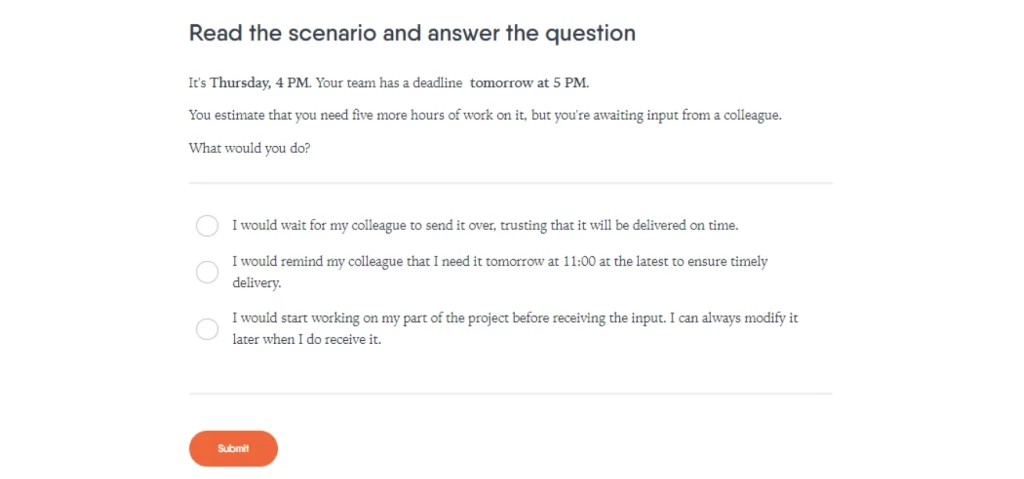Sera Özkıvanç is the content manager at Easygenerator. Over the last four years, she’s written marketing content for various SaaS brands around the world. These days, she’s doing her best to embrace the rainy weather in Rotterdam.
Role-play scenario questions in corporate learning
Unlock the potential of role-play scenario questions: prepare employees for real-world challenges by promoting decision-making moments.

What are role-play scenario questions?
Role-play scenario questions transport learners into realistic job-related situations, asking them to navigate them based on their knowledge and skills. They are an effective way to bridge the gap between theoretical knowledge and practical application.
Benefits of role-play scenario questions
Incorporating role-play scenarios in e-learning offers numerous advantages:
Enhances critical thinking
Learners must analyze situations and make decisions, boosting their problem-solving skills.
Increases engagement
Interactive scenarios captivate learners, making the training process more enjoyable and memorable.
Prepares for real-life situations
By simulating job-related tasks, employees can practice and hone their skills in a risk-free environment.
Promotes active learning
Learners actively participate in their education, leading to better retention of information.
Steps for creating role-play scenario questions
Creating effective role-play scenarios involves a few crucial steps:
- Identify what skills or knowledge the scenario should teach.
- Develop a storyline that learners might encounter in their job roles.
- Create characters that learners can relate to, complete with dialogues that propel the story.
- Offer multiple choices that lead to different outcomes, each reflecting possible real-world consequences.
- Give feedback on each decision, explaining why it was right or wrong and what can be learned from it.
Role play scenario example in e-learning
Consider the following role-play scenario example:

This scenario challenges learners to engage in higher-order thinking by putting them in a situation that requires analysis, evaluation, and decision-making—key components of Bloom’s Taxonomy. Learners must assess the situation, consider the potential outcomes of different actions, and make a decision they believe is most effective.
Feedback matters
After selecting an option, learners receive feedback. This feedback is crucial, especially if they choose the incorrect option; it should guide learners through the thought process that would lead to a better decision in a real-world context.
If you have time, providing specific feedback for each incorrect option yields the best results. See below:

See how each decision—right or wrong—becomes a learning opportunity?
Conclusion
Role-play scenario questions are a dynamic tool in corporate e-learning. By engaging employees in these immersive simulations, you can foster a more skilled, adaptable, and confident workforce. Your e-learning becomes more interactive and has significantly more relevance to learners’ day-to-day workload.




